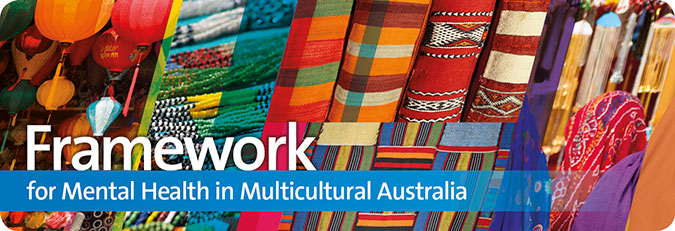Key concept 2
Risk and protective factors
When providing mental health services to people from culturally and linguistically diverse (CALD) communities a range of additional risk and protective factors need to be taken into consideration. The factors that are particularly important are migration and acculturation, racial discrimination and equity, language acquisition, and refugee experiences. These factors are inter-related and can exacerbate the likelihood of a mental illness or conversely protect against the development of a mental illness.
The social determinants of health (including mental health) are the conditions of the social world that influence the health and wellbeing of individuals and groups. These conditions are shaped by the distribution of money, power and resources at personal, local, national and global levels. Health status is not merely the result of personal or individual factors, but rather is a complex interrelationship of social and economic factors which can mediate health and mental health. The determinants for mental health include education level, employment status, gender, ethnicity and socio-economic class.
People from CALD backgrounds consistently have higher levels, and greater numbers, of socially determined risk factors for mental health problems. People from CALD backgrounds also share some specific experiences that can make them particularly vulnerable. Experiences such as migration, acculturative stress, racial discrimination and equity, language barriers and refugee experience can all expose CALD populations to additional risk factors. Conversely strong protective factors are also seen in CALD communities including strong family and community support, connection with culture and faith, good English language acquisition, educational attainment, employment and economic opportunities.
Racism in Australia
- The Australian Human Rights Commission found that people are more likely to experience racism if they have recently arrived in Australia, or are of an Arabic, Muslim or African background.
- The Challenging Racism Project researched experiences of racism and found that migrants and refugees most commonly reported:
- Experiences of race-hate talk (20%)
- Race-based exclusion from social activities and/or their workplace (11%)
- Physical attacks based on race or traditional dress (6%)
Australian Human Rights Commission, 2012
Migration and acculturation
Acculturation is the process by which migrants adjust psychologically and socially to their new environment during settlement. The process of acculturation can be a long one but many people acculturate successfully achieving a good balance between their culture of origin and the culture of their new country.
For some the acculturation process can cause high levels of stress (acculturative stress) which is a significant mental health risk factor for this group.
The experience and extent of acculturative stress is influenced by a number of factors, including:
- Acculturation attitude
- Migration status including reasons for migrating
- Personality and cognitive factors, such as self-esteem
- Other personal variables, such as gender and age
- Cultural distance and differences between the host culture and the person's culture of origin
- External factors, such as the attitudes and responses to immigrants in the new society.
High levels of acculturative stress are associated with high levels of depression and increased levels of anxiety. The process of acculturation is rarely straightforward or short-lived. In fact, the effects of the migration experience can be long term and enduring. Effects may even be felt across lifetimes and generations. Increased levels of depression and anxiety are seen in second and third generation individuals with acculturative stress. Acculturative stress may arise due to intergenerational family and cultural conflict.
Addressing factors that prevent successful acculturation can help individuals and communities to achieve better mental health outcomes. The host culture has an important role to play in helping immigrants to acculturate by building a multicultural community that accepts and is inclusive of, cultural diversity and difference. Mental health services also need to look at how they provide culturally responsive services and promote cultural diversity.
Racial discrimination and equity
Racial discrimination is expressed both interpersonally and systemically and can have a significantly negative impact on the mental health and wellbeing of CALD people and communities.
People who experience racism and discrimination have higher levels of psychological distress, psychosis, depression and other mental health disorders. There is a clear link between belonging to a group that is stigmatised or discriminated against, and poor mental health, physical illness and academic underachievement. This is not only the case for those who experience direct interpersonal discrimination, but also relates to those who perceive that their group is the target of discrimination.
Discrimination can also reduce rates of participation in a wide range of social and community activities that are known to be protective factors for mental health. It can impact on participation in the workforce, local neighbourhood and community networks and social and friendship groups. It can also impact on access rates to services.
Social and cultural inclusion can counter the impact of racism and discrimination. Working in partnership with CALD communities and key stakeholders, mental health services can effectively identify local problems and real solutions. The Framework for Mental Health in Multicultural Australia: Towards culturally inclusive service delivery (the Framework) provides mental health services with a good starting point to objectively review their organisation and build plans to become more culturally responsive. The ability to access appropriate health care services significantly impacts on health and wellbeing. Culturally inclusive mental health services have the potential to significantly improve mental health outcomes and consumer satisfaction for CALD consumers.
Language acquisition
A language barrier is a significant structural obstacle that can prevent people from accessing and receiving continuing mental health care, and attaining improved health status and outcomes. There is a strong association between language barriers and stress levels and instances of self-reported poor health. Those with low English language proficiency are more likely to seek assistance for mental health problems from primary care, rather than specialist providers. Language barriers may also limit or confuse communication about emotional and mental health problems, as the majority of the assessment and treatment options for mental illness are based on communication.
Stable and meaningful employment is a strong protective factor for mental health and wellbeing and language acquisition is associated with employment and underemployment. People with high levels of English are likely to experience greater levels of employment, more likely to experience employment commensurate with skills and qualifications and are more likely to be able to advocate for fair employment conditions. Furthermore education opportunities are available to those with suitable levels of English language proficiency.
Unemployment and underemployment impact on a person’s sense of self-worth and creates greater economic hardship which contributes to an increased risk of mental ill health. Language acquisition also impacts on a person’s ability to connect and engage with the local community including service providers, community groups, and neighbours. People who are proficient in the English language are going to be more easily able to access formal and informal supports thus reducing their risk of social isolation. Mental health services need to be particularly aware of the need to effectively address language barriers through good language services policies and also need to consider how to redress some of the social constraints for people with limited English.
The refugee experience
Refugees are among the world’s most vulnerable people and they are also often highly resilient having survived through terrible experiences. The refugee experience can include witnessing or experiencing violence, abuse, imprisonment and torture. Refugees often face hazardous journeys, life in refugee camps and loss of, or separation from, family members. These traumatic experiences can have an impact on their mental health and wellbeing and may put them at increased risk of developing posttraumatic stress disorder (PTSD). Similarly, there is a strong link between witnessing violence and the development of PTSD in children. Mental health services need to be aware that while a refugee may have a trauma history they may not experience a resultant mental illness. Rather the stress resulting from settlement and acculturation may be more acute and problematic in helping refugees attain or maintain good mental health.
Refugees who experience mental health problems as a result of their trauma experiences need to be provided with culturally responsive treatment and care so they can go on to experience good mental health and engage fully with community life in Australia.
Useful readings
Australian Human Rights Commission. (2012). Face the facts: Some questions and answers about Indigenous peoples, migrants and refugees and asylum seekers. Sydney: Australian Human Rights Commission.
Davidson, G., Murray, K. & Schweitzer, R. (2008). Review of refugee mental health and wellbeing: Australian perspectives, Australian Psychologist, 43 (3), 160-174.
Loue, S. & Sajatovic, M., (2009). Determinants of minority mental health and wellness, New York, Springer.
 Key Concept 2 - Risk and protective factors (211 KB)
Key Concept 2 - Risk and protective factors (211 KB)
Previous Page











